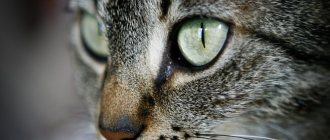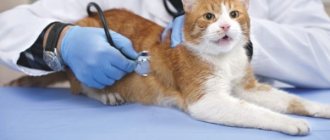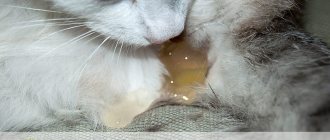The appearance of receding hairline: reasons
The area of the skin where hair has fallen out is called a receding hairline; such a change is not normal and can appear for various reasons, including:
- Allergic reaction to food, medications.
Allergies to food (industrial feed, lamb, cereals), medications often develop in cats. Signs of the pathological condition: baldness of the skin near the ears and eyes, on the stomach, constant itching, redness of the bald areas.
- Endocrine alopecia.
Hair loss may indicate hormonal imbalances in the animal’s body, indicating the development of diseases such as: pathologies of the thyroid gland, diabetes mellitus, malfunction of the adrenal glands, malfunctions of the internal glands. Additional signs of hormonal imbalance are: excessive drinking of water, frequent urination, sudden weight loss.
- Parasites.
Hair loss can occur if the cat is infected with ringworm. Infection occurs through contact with a carrier of parasites; the disease may not manifest itself for a long time. Subcutaneous mites begin to actively develop if the pet’s immunity is weakened.
Additional symptoms: flaky skin, the formation of bleeding wounds, ulcers above the eyes. Fleas can also cause baldness, biting parasites bother the animal, the cat begins to intensively scratch the skin, as a result of which the hair roots become weak and the hair falls out.
- Scabies, lichen.
Be sure to read:
Why does a cat shake its ears and head constantly, causes of itching, how to help and what to do
Bald spots may indicate the development of infectious diseases, such as lichen or scabies.
This is interesting: What to do if a cat has a lump on his back under the skin?
Alopecia, or feline hair loss: what is it?
All cats shed twice a year, and this is the norm. How to distinguish: is it molting (the process when the fur is renewed) or pathology (baldness of the animal)? To do this, you need to know how the disease manifests itself, what its prerequisites are and in what cases the owner needs to sound the alarm.
Alopecia is the name given to abnormal hair loss in cats, as a result of which bald spots are formed on the animal's body - areas with absolutely no hair. The fur may fall out in clumps, forming bald areas on the animal's head, ears, and paws. Having noticed such areas, the owner should immediately take the pet to an appointment with a veterinarian. Baldness can be a signal of serious problems in the animal’s body.
But this should not be confused with hair loss, which normally occurs in all healthy felines. Cats lose their fur during:
- molting (a seasonal change of “coat” occurs twice a year; cats usually shed more than males);
- stress (the animal may shed some hair due to excitement);
- age-related changes (old animals lose hair and whiskers);
- frequent bathing (this is why it is recommended to bathe the animal only if necessary; twice a year is quite enough).
At the same time, the wool does not come out in clumps, without forming bald spots. But the disease has slightly different symptoms.
Diagnosis of the disease
Only an experienced veterinarian can determine why bald patches appear above the eyes and in the ear area in cats. He carries out the following diagnostic measures:
- analyzes the pet's medical history;
- conducts a thorough examination of the cat;
- carries out microbiological examination of animal hair roots;
- prescribes specific and general blood tests;
- takes a scraping of the epidermis;
- To identify signs of neoplasms, the veterinarian prescribes an ultrasound or x-ray.
Baldness treatment
If the owner notices that the cat's ears are peeling, the pet is immediately taken to the doctor.
The veterinarian performs a number of manipulations:
- Examines the cat for parasites.
- Takes a skin scraping to determine a skin infection.
- Performs a blood test to detect inflammation in the pet's body.
- Conducts an analysis of the animal's hormonal levels.
- Additional studies may be performed to clarify the diagnosis.
Based on the examination results, the doctor prescribes home treatment and advises the owner on the cat’s nutritional issues.
Vaccinating your cat helps against diseases that cause hair loss
Why is there a problem?
In veterinary medicine, hair loss in the area of the ears and other parts of the cat’s body is called alopecia. The following factors can influence the occurrence of bald spots above the eyes:
- Allergic reaction. The source of allergies are toxic substances, dry food and some food products, medications and more. When your cat is exposed to allergens, his bald spots increase and severe itching and irritation occur.
- Otodectosis or scabies. The disease, which causes hair loss on the head and in the ears, is caused by the activity of ear mites. If not treated in a timely manner, the disease leads to otitis media.
- Ringworm and other fungal infections. The fungus poses a health hazard to cats, especially kittens, and can lead to baldness. It is worth contacting a veterinarian as soon as your pet’s fur begins to fall out and redness occurs.
- Viral diseases. Against the background of the disease, symmetrical alopecia and other unpleasant symptoms may occur. Bald spots due to viral diseases are visible not only in the ears, but also in the area of the hind legs and other parts of the body.
- Hormonal imbalances. A pregnant cat faces similar problems, and baldness can also occur due to hyper- or hypothyroidism.
- Hereditary factor. Baldness can be caused by gene mutations that are inherited.
Veterinarians do not recommend exposing pets to severe stress, since against this background the animal may refuse to eat and become restless, including the cat becoming bald in the ear area.
Causes of baldness in kittens
The problem of baldness in kittens may be related to their diet, so it is worth balancing it and adding vitamins.
If a young representative of the cat family has bald ears, this does not always indicate a pathological process. Owners should pay attention to the kitten's nutrition. It is not recommended to suddenly change one food to another or try to somehow diversify the animal’s diet. If the problem lies in an unbalanced diet, then it is worth giving the animal vitamins. Baldness on the hind legs, ears and other parts of the body can also be a consequence of insufficient function of the immune system.
Rare causes of patchy hair loss in cats
It happens that the reason for the formation of a bald spot on a cat’s ear, temple or face is so rare and unusual that even experienced veterinarians initially find it difficult to diagnose it. These include:
- heredity;
- individual genetic mutations;
- adenitis;
- hyperplasia.
Technically, the cause of baldness can be any pathology - from bacterial or viral infections to cancerous tumors. All of them damage the immunity of a living creature. When there are too many such negative influences, the body begins to experience a lack of resources for recovery. By “saving” on what is not so necessary, the body “turns off” some of its functions, for example, maintaining a healthy coat. In cats, this can cause, among other things, alopecia areata.
Bald patches near the ears
The development of characteristic bald spots near the ears of an animal (periacular alopecia) occurs in a cat for the same reasons as hair loss above the eyes.
To make a diagnosis and prescribe treatment, your pet should be taken to a veterinary clinic, where the doctor:
- will conduct a visual inspection,
- will prescribe a series of tests,
- take scrapings from the skin,
- Based on the data obtained, he will prescribe treatment.
Causes associated with pathologies
When large bald patches appear on a cat’s ears, the first thing to consider is one of the types of allergies, which often manifests itself not only in hair loss, but also in redness and flaking of the skin. Almost 80% of cases are associated with food allergies, which are acute in elite breeds. The remaining cases are due to allergies after insect bites or contact with potential allergens (household chemicals, medications). Unfortunately, among elite breeds there are many cases of chronic atopic dermatitis - an allergic reaction can be triggered by the hair of carpets, other animals, house dust and mold, pollen and other substances, which are almost impossible to exclude from everyday life. Here the animal can only receive symptomatic treatment during an exacerbation period. With a food allergy, it is more difficult to look for the allergen, but if you can find it, then eliminating it from the diet can guarantee the pet’s complete recovery (by recovery we mean the disappearance of all symptoms).
- Flea dermatitis. A common reaction in cats to flea bites. The reaction is caused by the parasite's saliva, which enters the animal's bloodstream after the bite. In some cases, one flea is enough to provoke a severe allergic reaction, which most often manifests itself in the form of bald patches on the ears, withers, neck and chest. Peeling and itching are almost always present. Also characteristic signs can be the appearance of white and black grains in the pet’s fur, which many owners mistake for dirt or dandruff. This is actually the result of the life of parasites. For fleas, it is best to use special preparations (in the form of drops), which are applied to the animal’s withers monthly during the parasite activity season and once every three months in the winter. The best today are Stronghold and Advocate, which are produced abroad. Among domestic manufacturers, we can highlight a drug called Barrier.
- Bacterial infection. It can get into an open wound after scratches from claws or bites from the teeth of other animals. Bald patches on a cat's ears may indicate the presence of itching, which causes the pet to scratch itself. In severe cases, blood and pus appear in places where scratching occurs, which emit an unpleasant odor. To make a diagnosis and determine the pathogen, it is necessary to take deep scrapings from the surface of the lesions for cytological examination. In difficult cases, it is necessary to do a culture. Based on the results obtained, antibacterial drugs are selected. Treatment is long-term and can take up to several weeks, depending on the number and extent of the lesions.
- Ear mites are considered one of the most common causes of otitis media in cats. The activity of parasites manifests itself in the form of dirty discharge from the ears, an unpleasant odor and redness of the skin inside the ear. Bald patches on the ears indicate the presence of severe itching, which often drives pets crazy, forcing them to scratch themselves until they bleed. Otodectosis can only be confirmed in a laboratory using a microscopic examination of deep plucks from each ear. For treatment, drugs are used that are applied to the animal’s withers or instilled inside the ear canal. Treatment is carried out on all animals living in the house, regardless of the presence of symptoms.
As you may have noticed, most of the reasons that cause the appearance of bald patches on the ears of cats are associated with the activity of parasites, which can be easily prevented by regular preventive treatment of your pets.
The cat has bald patches and sores above the eyes
One of the causes of hair loss and the appearance of sores is a serious disease that affects the cat's sweat glands (sweat gland cyst). The disease is typical for elderly and weakened animals. Ulcers develop on the pet's skin, inflammation begins, which leads to hair loss.
This is interesting: What to do if a cat is limping on its hind leg?
Maybe it's mycosis?
Mycosis, or fungal infection, is the second common cause of hair loss around the eyes and ears in cats. It is not for nothing that people clearly associate bald spots on animal fur with the diagnosis of “lichen.” What kind of disease is this?
Dermatophytosis is a fungal infection of the fur, skin and claws of an animal caused by microorganisms of the microsporum or trichophyton species. In both cases, the following symptoms are observed:
- inflammation of the skin and bald patches on the affected areas of the body (on the head behind the ear, on the paws, at the base of the tail, etc.);
- dandruff;
- unpleasant smell.
Why does dermatophytosis occur? Microsporum and trichophyton live in small quantities on the animal's skin permanently and are not considered pathogenic. However, if the rules for keeping a pet are neglected, conditions favorable for the development of mycosis may arise. According to the observations of veterinarians, most often the disease occurs due to:
- violations of hygiene standards;
- feeding and care inappropriate for the age and health of the animal;
- weakening of the cat's immunity caused by aging, pregnancy or other stressful factors for the body.
How to help your pet if he has mycosis? Any fungal disease requires complex treatment using modern drugs for external and internal use. Only a veterinarian can prescribe such therapy by choosing the most effective and safe medications.
The appearance of bald patches: what to do
A cat owner who notices the appearance of bald spots should not self-medicate. The pet should be taken to a veterinarian to determine the cause of the illness. The doctor will conduct an examination and prescribe adequate treatment.
Prevention measures:
- feeding with quality feed,
- regular hygiene procedures,
- timely vaccination of the animal,
- taking vitamin complexes,
- regular checkups with a veterinarian.
Be sure to read:
The cat has black dots on his chin under the fur: what are they, causes, medications and folk remedies
Diagnostic methods
If your cat's ears are going bald, there is brown discharge from the ears and redness of the skin, then you should contact a veterinarian for help. The specialist will examine the area with lost hair and become familiar with the symptoms that are bothering the pet. If it is not possible to visually determine the cause and severity of the disease due to which the bald spot appeared, then additional diagnostic procedures are prescribed. To make a diagnosis, the following manipulations may be required:
- laboratory testing of blood and urine;
- bacterial culture of urine;
- scraping from the damaged area with further microscopy;
- ultrasound diagnostics of internal organs if there is a suspicion of a violation of their function;
- allergic reaction test.
Baldness in kittens
Minor bald patches on a kitten's ears can be a manifestation of serious illnesses that need to be treated. Over time, the disease becomes chronic, sometimes leading to the death of the cat. That is why, if a bald spot appears on the inside or outside of the ear, you should immediately seek medical help at a clinic.
A cat has a black nose: causes of discharge and treatment options
Hair loss can occur due to a lack of vitamins and poor nutrition. A hairless kitten is most susceptible to skin infections due to the presence of exposed areas of the body.
Often, scanty hair can be caused by poor nutrition of a nursing cat. Breast milk does not supply enough vitamins, and the baby begins to go bald.
Recommended! To prevent diseases, the kitten should be shown to a veterinarian. He will examine and vaccinate the animal.
What is the normal coat of hair on a cat's ears and above the eyes?
Before diagnosing your pet yourself, it is worth clarifying what the hair on the face of a healthy animal should look like. Are small bald spots under the eyes and ears of an animal a sign that it is going bald?
According to the observations of felinologists, the presence of small “gaps” in the fur on a cat’s temples is an absolute norm. If you look closely at the pet, it turns out that the bare “spots” found on its face are bald patches in the usual sense of the word, but just areas covered with lighter, shorter and sparse (compared to the rest of the head) hairs.
It is easy to make sure that small bald spots on the temples are a physical feature characteristic of a biological species, and not a sign of a disease. Suffice it to remember that hairless spots on the pet’s face were always present - both when he was a kitten and when he became an adult.
Prevention
A cat's tooth fell out: main symptoms and treatment options
To prevent a cat from developing a bald spot on its head, there are a number of preventive measures. The pet is periodically examined, regularly given prophylaxis against worms, and a balanced diet is selected. The animal is promptly vaccinated against diseases. Your pet should not be walked near places where stray cats accumulate.
Attention! Long-haired cats need to be brushed frequently. It is necessary to monitor the cleanliness of the fur of all cat species.
Diet
You need to put your cat on a diet diet. Do not feed your animal dry food, as industrial food contains a large amount of preservatives and artificial flavors.
It is recommended to feed your pet boiled dietary meat - veal, rabbit, turkey. You can add seasonal vegetables and fruits to your diet.
If a pregnant cat has a bald spot on her ear, the reason is a lack of vitamins, which she does not receive from food. Such pets need special nutrition rich in nutrients.
Important! It is forbidden to feed the cat sweets, smoked meats, and salty foods. Such products are strong allergens.
Protect from stress
A nervous situation in the house, the appearance of children or other animals - all these factors adversely affect the cat’s psyche and can cause bald spots in a cat.
If a cat reacts painfully to changes in his life schedule, the arrival of guests, or a change of environment, you need to try to protect him from stress. You can treat your pet’s nerve pain with sedatives, which should be prescribed by a veterinarian.
Regular inspection
To detect baldness at an early stage and prevent further hair loss, you need to constantly examine your pet. Once every six months the cat is taken to a veterinarian for examination. They take tests and conduct an external examination. If signs of illness or bald patches appear on the animal, treatment is carried out.
Abrasions and scratches that your pet received in the game must be treated with a disinfectant solution.
Examining your cat at a veterinary clinic will help identify the disease in time.
Regular visits to the veterinary clinic, proper nutrition, and grooming are the conditions under which the animal will be healthy. This is why you need to pay attention to the cat. And if a cat’s ears become bald, he is urgently taken to a doctor for examination.
How to treat: effective methods
A veterinarian will help determine the causes of hair loss in your pet, who will conduct an examination and prescribe therapy.
When self-induced alopecia appears in cats, as a result of which the stomach, ears, heels and often other bodies become bald, then you should not delay a visit to the veterinarian. The doctor will find out why hair grows poorly and falls out around the ears, and then select the necessary therapeutic actions. If a cat has hair loss above the eyes due to an allergic reaction, then no special treatment may be required, but it is enough to exclude the animal from contact with the allergen. For a pet that may be irritated by certain odors and other substances, it is worth choosing hypoallergenic food so that the pathology does not recur and complications do not arise. In case of advanced allergies, due to which the stomach, ears and other areas become bald, medications with antihistamine action will be required to eliminate alopecia in cats.
Bald patches caused by bacteria or viruses need to be treated with medication using various means. The following groups of medications are used to eliminate bald spots:
- antibiotics;
- immunostimulants;
- vitamin complexes.
A cat's receding hairline also requires adjustments to its daily diet. The pet needs to be fed high-quality food that contains the vitamins and microelements necessary for the cat’s body. Often, hairless cats and other members of the feline family encounter problems due to severe stress. If the deviation cannot be resolved without medication, then pills are prescribed that improve the animal’s mood.
How to treat alopecia in cats
The nature of the treatment depends on the cause that provoked the appearance of local bald patches. If the disease is allergic, it is necessary to isolate the animal from exposure to allergens. “The veterinarian should prescribe immunostimulants and antiallergic drugs to the cat.” In addition, the animal must adhere to a special hypoallergenic diet.
If alopecia is caused by parasites, the animal is recommended to use special sprays, gels, and ointments that have antiparasitic properties. In addition, the cat should additionally take vitamin complexes to stimulate immune function.
Abscess and pyoderma, which also provoke alopecia, are treated by treating the skin with systemic and external antibiotics, as well as antiseptics.
Naturally, treatment will directly depend on the cause of baldness. In the case of a banal allergic reaction, it is enough just to protect the pet from the source of the pathogen. In this case, the veterinarian will prescribe special antiallergic drugs and immunostimulants. Also, do not forget about the special diet that you will have to adhere to during therapy.
If baldness is caused by parasites, then it is important for your pet to use different ointments and sprays that can get rid of this problem once and for all. Among other things, the pet must also take vitamin complexes to maintain its strength.
In case of endocrine alopecia, it is necessary to take special hormonal medications. If baldness is psychogenic in nature, it is necessary to take special sedatives and sedatives.
Bald patches in cats above the eyes and near the ears are a serious but treatable pathology. For each animal, the veterinarian selects individual therapy depending on the causes of the disease:
- 1. If the pathology is caused by an allergy, the cat must be isolated from contact with the allergen. After which the veterinarian will prescribe antiallergic drugs and drugs to enhance immunity. In case of food allergies, the animal is prescribed a diet.
- 2. If parasites are detected, the cat should be treated with special anti-parasitic agents and additionally given drugs to enhance immunity.
- 3. In case of abscesses, the cat must undergo a course of treatment with antiseptics and antibiotics.
- 4. In case of endocrine disorders, the doctor will prescribe hormonal medications.
- 5. If a cat has a malfunction of the sebaceous glands, it is necessary to use antiseborrheic agents and retinoids.
- 6. In case of weakened condition, vitamins and a special diet are prescribed.
Why do my cat's ears go bald?
When owners notice that a cat’s ears are going bald, they should pay attention to the animal’s diet, since a similar problem is possible due to a lack of vitamins and microelements in the cat’s body. Baldness around the ears may also indicate endocrine and other serious diseases that require urgent medical treatment. As soon as a kitten has areas without hair near its ears, its legs become bald, and other symptoms of a sore appear, it is worth contacting a veterinary clinic for examinations and selection of therapy.
Causes of bald ears in cats
The animal body is similar to the human body in the sense that if something is wrong with the internal organs, this is reflected in the external appearance. Hair loss in the ear area and, in general, hair loss on any skin is a cause for concern. The best thing to do in such a situation is to contact a specialist who is more qualified in identifying the causes, but there are the most common ones.
- Dermatitis . This skin disease, triggered by a reaction to all kinds of irritants, occurs not only in humans. Cats are also familiar with it. Usually, dermatitis, along with baldness of the ears, is accompanied by the formation of bumps on the skin. Its appearance can be caused by an allergy to a new medicine or even a houseplant, but most often it is an intolerance to a certain food. In veterinary practice, it is not uncommon for a cat to experience bald ears after feeding it regular food - chicken, fish, meat.
- Bacterial skin diseases. The penetration of bacteria into the cat’s body also occurs for some reason. It could be a wound or a vitamin deficiency due to poor nutrition. All this reduces the overall resistance of the immune system to attacks from harmful bacteria.
- Viral infections. Their list is very impressive - this is an analogue of human flu, and damage to the eyes and respiratory tract, and the intestines of an animal. To figure out what kind of virus your cat has, a trip to the veterinarian is required. One of the symptoms of an infection in a pet’s body is baldness of the ears.
- Stress. Pets also tend to experience emotional turmoil, and sometimes their experiences lead to the fact that the nervous system cannot withstand the stress. This leads to disruption of the functioning of the entire body and, in particular, to baldness. If the owners, for example, changed their place of residence and after that the cat’s ears began to go bald, then most likely the problem is stress.
- Lichen. This is a disease caused by the fungi Trichophyton and Microsporum. Common sites of occurrence include the ears. First of all, it is necessary to exclude lichen as one of the possible causes of baldness, because he is one of the most dangerous. Carrying out an examination of a cat on your own does not guarantee the accuracy of the diagnosis, and incorrect treatment can even worsen an already unfavorable situation for the animal’s health. Veterinarian help, and emergency help, is necessary if the cat, in addition to a bald spot on the ear, has redness, blisters, and the bald spot itself has become wet.
What to do if your cat's ears are going bald
A large list of reasons that can provoke baldness of an animal’s skin in the ear area excludes the possibility of independently determining the only correct one. Therefore, it is better to consult a doctor , because... Only a qualified and experienced veterinarian will be able to resolve doubts at first glance and say what exactly happened to the pet. There is no point in being scared in advance - the owner may simply have to exclude chicken or another product from the cat’s diet, or it may require long-term and expensive treatment with antibiotics.










